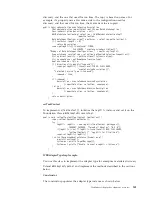
BootStrap:
WebSphere Integration Developer performs a bootstrap step to identify a resource
adapter that has been enabled for enterprise metadata discovery service.
To identify a resource adapter that is enabled for metadata discovery service,
WebSphere Integration Developer launches a bootstrap step to find a
discovery-service.xml
file. This file should be located in the
META-INF
folder for
the resource adapter. An example of this file is found in the sample delivered with
the WebSphere Adapter Toolkit.
Resource bundles:
Resource bundle files capture properties and logging and tracing messages that are
germane to an enterprise metadata discovery implementation.
Each enterprise metadata discovery implementation must have two resource
bundle files. One captures the property group and property names and
descriptions for properties displayed by WebSphere Integration Developer tooling.
The other is for messages written to the log file for tracing. The bundle names
must follow the convention of including the
EMD.properties
file in the enterprise
metadata discovery package as shown in the following examples:
v
com.<
company name
>.j2c.<app name>.emd.EMD.properties
to capture resource
bundles for property groups
v
com.<
company name
>.j2c.<app name>.emd.LogMessages.properties
to capture
logging and tracing resource bundles.
The property groups representing resource adapter, managed connection factory,
and the Activation Specification must have property names matching their bean
properties.
Property groups:
All the properties used in the discovery service are represented by the
PropertyGroup
set of interfaces.
A property group is a collection of properties. A property group can be associated
with the
Inbound
- and
OutboundConnectionConfiguration
,
MetadataTree
, nodes of
the
MetadataTree
(
MetadataObject
and
MetadataSelection
).
PropertyGroup
supports nesting and can therefore include child
PropertyGroups
. It also provides a
listener and an event interface to trickle changes from one property into another
property or property group.
The Adapter Foundation Classes provide a complete implementation of the
PropertyGroup
APIs. Individual discovery service implementations should not
implement these APIs.
The keys properties of this API set are as follows:
v
SingleValuedProperty
– Allows a single property of any Java type. It includes
attributes such as required, sensitive, hidden, primitive, default value, and valid
values.
v
MultiValuedProperty
– Allows a property to be represented as a list of values.
For example, you can represent the operations for a
BusinessObject
using this
type of property and then make multiple selections.
WebSphere Adapter development overview
137
Summary of Contents for WebSphere Adapters
Page 2: ......
Page 6: ...iv WebSphere Adapters WebSphere Adapter Toolkit User Guide...
Page 220: ...214 WebSphere Adapters WebSphere Adapter Toolkit User Guide...
Page 224: ...218 WebSphere Adapters WebSphere Adapter Toolkit User Guide...
Page 225: ......
Page 226: ...Printed in USA...
















































